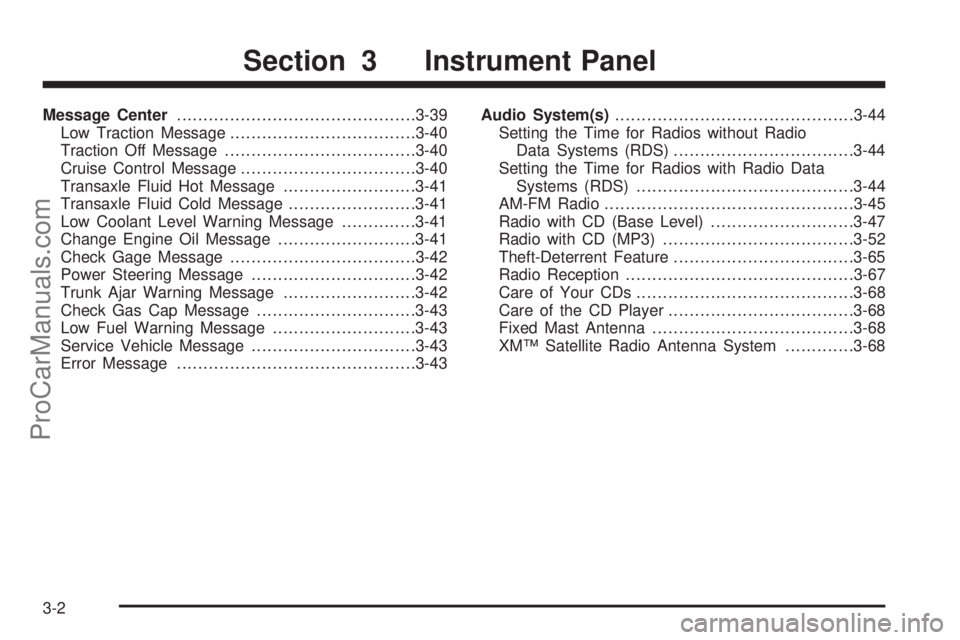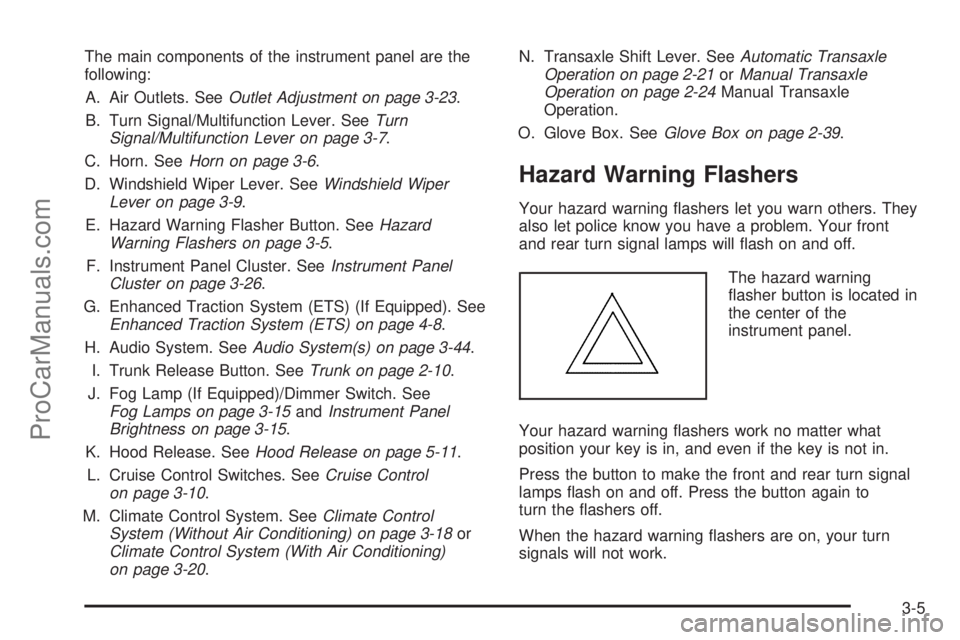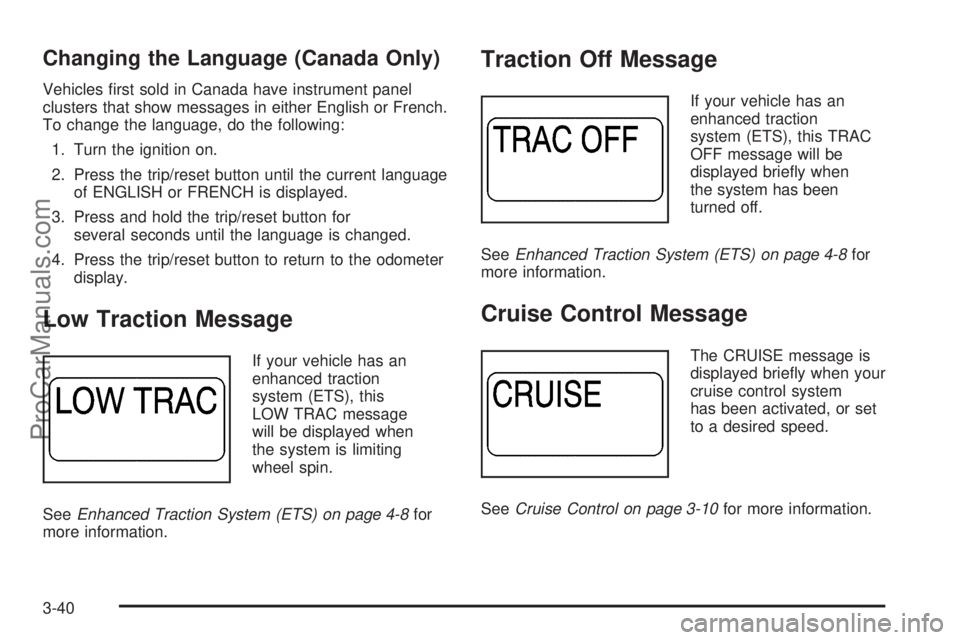traction control SATURN ION 2005 Owners Manual
[x] Cancel search | Manufacturer: SATURN, Model Year: 2005, Model line: ION, Model: SATURN ION 2005Pages: 366, PDF Size: 2.74 MB
Page 110 of 366

Message Center.............................................3-39
Low Traction Message...................................3-40
Traction Off Message....................................3-40
Cruise Control Message.................................3-40
Transaxle Fluid Hot Message.........................3-41
Transaxle Fluid Cold Message........................3-41
Low Coolant Level Warning Message..............3-41
Change Engine Oil Message..........................3-41
Check Gage Message...................................3-42
Power Steering Message...............................3-42
Trunk Ajar Warning Message.........................3-42
Check Gas Cap Message..............................3-43
Low Fuel Warning Message...........................3-43
Service Vehicle Message...............................3-43
Error Message.............................................3-43Audio System(s).............................................3-44
Setting the Time for Radios without Radio
Data Systems (RDS)..................................3-44
Setting the Time for Radios with Radio Data
Systems (RDS).........................................3-44
AM-FM Radio...............................................3-45
Radio with CD (Base Level)...........................3-47
Radio with CD (MP3)....................................3-52
Theft-Deterrent Feature..................................3-65
Radio Reception...........................................3-67
Care of Your CDs.........................................3-68
Care of the CD Player...................................3-68
Fixed Mast Antenna......................................3-68
XM™ Satellite Radio Antenna System.............3-68
Section 3 Instrument Panel
3-2
ProCarManuals.com
Page 113 of 366

The main components of the instrument panel are the
following:
A. Air Outlets. SeeOutlet Adjustment on page 3-23.
B. Turn Signal/Multifunction Lever. SeeTurn
Signal/Multifunction Lever on page 3-7.
C. Horn. SeeHorn on page 3-6.
D. Windshield Wiper Lever. SeeWindshield Wiper
Lever on page 3-9.
E. Hazard Warning Flasher Button. SeeHazard
Warning Flashers on page 3-5.
F. Instrument Panel Cluster. SeeInstrument Panel
Cluster on page 3-26.
G. Enhanced Traction System (ETS) (If Equipped). See
Enhanced Traction System (ETS) on page 4-8.
H. Audio System. SeeAudio System(s) on page 3-44.
I. Trunk Release Button. SeeTrunk on page 2-10.
J. Fog Lamp (If Equipped)/Dimmer Switch. See
Fog Lamps on page 3-15andInstrument Panel
Brightness on page 3-15.
K. Hood Release. SeeHood Release on page 5-11.
L. Cruise Control Switches. SeeCruise Control
on page 3-10.
M. Climate Control System. SeeClimate Control
System (Without Air Conditioning) on page 3-18or
Climate Control System (With Air Conditioning)
on page 3-20.N. Transaxle Shift Lever. SeeAutomatic Transaxle
Operation on page 2-21orManual Transaxle
Operation on page 2-24Manual Transaxle
Operation.
O. Glove Box. SeeGlove Box on page 2-39.
Hazard Warning Flashers
Your hazard warning �ashers let you warn others. They
also let police know you have a problem. Your front
and rear turn signal lamps will �ash on and off.
The hazard warning
�asher button is located in
the center of the
instrument panel.
Your hazard warning �ashers work no matter what
position your key is in, and even if the key is not in.
Press the button to make the front and rear turn signal
lamps �ash on and off. Press the button again to
turn the �ashers off.
When the hazard warning �ashers are on, your turn
signals will not work.
3-5
ProCarManuals.com
Page 118 of 366

Cruise Control
With cruise control, you can maintain a speed of about
25 mph (40 km/h) or more without keeping your foot
on the accelerator. This can really help on long
trips. Cruise control does not work at speeds below
25 mph (40 km/h).
{CAUTION:
Cruise control can be dangerous where you
cannot drive safely at a steady speed. So, do
not use your cruise control on winding roads
or in heavy traffic.
Cruise control can be dangerous on slippery
roads. On such roads, fast changes in tire
traction can cause needless wheel spinning,
and you could lose control. Do not use cruise
control on slippery roads.
Setting Cruise Control
{CAUTION:
If you leave your cruise control on when you
are not using cruise, you might hit a button
and go into cruise when you do not want to.
You could be startled and even lose control.
Keep the cruise control switch off until you
want to use cruise control.
3-10
ProCarManuals.com
Page 119 of 366

The cruise control buttons are located on the steering
wheel.
J(On/Off):Press this button to turn the cruise
control system on and off.
+RES (Resume):Press this part of the button to
resume a set speed and to accelerate the speed.
−SET (Set):Press this part of the button to set a speed
and to decrease the speed.
To set a speed do the following:
1. Press the on/off button to turn cruise control on.
The indicator light on the button will come on.
2. Get to the speed you want.
3. Press the−SET part of the control button and
release it. The CRUISE message will display in
the instrument panel cluster to show the system is
engaged.
4. Take your foot off the accelerator pedal.When the brakes are applied, the cruise control
shuts off.
If the vehicle is in cruise control and the Enhanced
Traction System (ETS) begins to limit wheel spin, the
cruise control will automatically disengage. See
Enhanced Traction System (ETS) on page 4-8. When
road conditions allow, the cruise control can be
used again.
Resuming a Set Speed
Suppose you set your cruise control at a desired speed
and then you apply the brake. This, of course,
disengages the cruise control. The CRUISE message in
the instrument panel cluster will also go out indicating
cruise is no longer engaged. To return to your previously
set speed, you do not need to go through the set
process again. Once you’re going about 25 mph
(40 km/h) or more, you can press the +RES part of the
button brie�y.
This will take you back up to your previously chosen
speed and stay there.
3-11
ProCarManuals.com
Page 148 of 366

Changing the Language (Canada Only)
Vehicles �rst sold in Canada have instrument panel
clusters that show messages in either English or French.
To change the language, do the following:
1. Turn the ignition on.
2. Press the trip/reset button until the current language
of ENGLISH or FRENCH is displayed.
3. Press and hold the trip/reset button for
several seconds until the language is changed.
4. Press the trip/reset button to return to the odometer
display.
Low Traction Message
If your vehicle has an
enhanced traction
system (ETS), this
LOW TRAC message
will be displayed when
the system is limiting
wheel spin.
SeeEnhanced Traction System (ETS) on page 4-8for
more information.
Traction Off Message
If your vehicle has an
enhanced traction
system (ETS), this TRAC
OFF message will be
displayed brie�y when
the system has been
turned off.
SeeEnhanced Traction System (ETS) on page 4-8for
more information.
Cruise Control Message
The CRUISE message is
displayed brie�y when your
cruise control system
has been activated, or set
to a desired speed.
SeeCruise Control on page 3-10for more information.
3-40
ProCarManuals.com
Page 177 of 366

Your Driving, the Road, and Your Vehicle..........4-2
Defensive Driving...........................................4-2
Drunken Driving.............................................4-2
Control of a Vehicle........................................4-5
Braking.........................................................4-5
Anti-Lock Brake System (ABS).........................4-6
Braking in Emergencies...................................4-8
Enhanced Traction System (ETS).....................4-8
Limited-Slip Differential....................................4-9
Steering........................................................4-9
Off-Road Recovery.......................................4-12
Passing.......................................................4-12
Loss of Control.............................................4-13
Driving at Night............................................4-15
Driving in Rain and on Wet Roads..................4-16City Driving..................................................4-19
Freeway Driving...........................................4-20
Before Leaving on a Long Trip.......................4-21
Highway Hypnosis........................................4-22
Hill and Mountain Roads................................4-22
Winter Driving..............................................4-24
If Your Vehicle is Stuck in Sand, Mud, Ice
or Snow...................................................4-28
Rocking Your Vehicle to Get It Out.................4-29
Loading Your Vehicle....................................4-29
Towing..........................................................4-34
Towing Your Vehicle.....................................4-34
Recreational Vehicle Towing...........................4-34
Towing a Trailer...........................................4-37
Section 4 Driving Your Vehicle
4-1
ProCarManuals.com
Page 181 of 366

{CAUTION:
Drinking and then driving is very dangerous.
Your re�exes, perceptions, attentiveness,
and judgment can be affected by even a
small amount of alcohol. You can have a
serious — or even fatal — collision if you drive
after drinking. Please do not drink and drive or
ride with a driver who has been drinking. Ride
home in a cab; or if you are with a group,
designate a driver who will not drink.
Control of a Vehicle
You have three systems that make your vehicle go where
you want it to go. They are the brakes, the steering, and
the accelerator. All three systems have to do their work at
the places where the tires meet the road.
Sometimes, as when you are driving on snow or ice,
it is easy to ask more of those control systems than the
tires and road can provide. That means you can
lose control of your vehicle. SeeEnhanced Traction
System (ETS) on page 4-8.
Braking
Braking action involves perception time and
reaction time.
First, you have to decide to push on the brake pedal.
That is perception time. Then you have to bring up your
foot and do it. That is reaction time.
Average reaction time is about three-fourths of a
second. But that is only an average. It might be less
with one driver and as long as two or three seconds or
more with another. Age, physical condition, alertness,
coordination, and eyesight all play a part. So do alcohol,
drugs, and frustration. But even in three-fourths of a
second, a vehicle moving at 60 mph (100 km/h) travels
66 feet (20 m). That could be a lot of distance in an
emergency, so keeping enough space between
your vehicle and others is important.
And, of course, actual stopping distances vary greatly
with the surface of the road, whether it is pavement
or gravel; the condition of the road, whether it is
wet, dry, or icy; tire tread; the condition of your brakes;
the weight of the vehicle; and the amount of brake
force applied.
4-5
ProCarManuals.com
Page 184 of 366

Using Anti-Lock
Do not pump the brakes. Just hold the brake pedal
down �rmly and let anti-lock work for you. You may feel
a slight brake pedal pulsation or notice some noise,
but this is normal.
Braking in Emergencies
At some time, nearly every driver gets into a situation
that requires hard braking.
If you have anti-lock brakes, you can steer and brake at
the same time. However, if you do not have anti-lock
brakes, your �rst reaction — to hit the brake pedal hard
and hold it down — may be the wrong thing to do.
Your wheels can stop rolling. Once they do, the vehicle
cannot respond to your steering. Momentum will
carry it in whatever direction it was headed when the
wheels stopped rolling. That could be off the road, into
the very thing you were trying to avoid, or into traffic.
If you do not have anti-lock brakes, use a “squeeze”
braking technique. This will give you maximum braking
while maintaining steering control. You can do this
by pushing on the brake pedal with steadily increasing
pressure.
In an emergency, you will probably want to squeeze the
brakes hard without locking the wheels. If you hear or
feel the wheels sliding, ease off the brake pedal.This will help you retain steering control. If you do have
anti-lock brakes, it is different. SeeAnti-Lock Brake
System (ABS) on page 4-6.
In many emergencies, steering can help you more than
even the very best braking.
Enhanced Traction System (ETS)
Your vehicle may have an Enhanced Traction
System (ETS) that limits wheel spin. This is especially
useful in slippery road conditions. The system operates
only if it senses that one or both of the front wheels
are spinning or beginning to lose traction. When
this happens, the system reduces engine power and
may also upshift the transaxle to limit wheel spin.
The LOW TRAC message will be displayed when your
Enhanced Traction System is engaged and limiting
wheel spin. SeeLow Traction Message on page 3-40.
You may feel or hear the system working, but this
is normal.
If your vehicle is in cruise control when the Enhanced
Traction System begins to limit wheel spin, the
cruise control will automatically disengage. When road
conditions allow you to safely use it again, you may
re-engage the cruise control. SeeCruise Control
on page 3-10.
4-8
ProCarManuals.com
Page 185 of 366

The Enhanced Traction System operates in all transaxle
shift lever positions. But the system can upshift the
transaxle only as high as the shift lever position
you have chosen, so you should use the lower gears
only when necessary.
The Enhanced Traction System automatically comes on
whenever you start your vehicle. The light on the
traction control button will also come on to let you know
the system is on. To limit wheel spin, especially in
slippery road conditions, you should always leave the
system on. But you can turn the traction control system
off if you ever need to. You should turn the system
off if your vehicle ever gets stuck in sand, mud or snow
and rocking the vehicle is required. SeeRocking
Your Vehicle to Get It Out on page 4-29andIf Your
Vehicle is Stuck in Sand, Mud, Ice or Snow on
page 4-28.
To turn the system on or
off, press the enhanced
traction system button
located on the instrument
panel switchbank.When you turn the system off, the TRAC OFF message
will be displayed. If the Enhanced Traction System is
limiting wheel spin when you press the button to turn the
system off, the TRAC OFF message will be displayed, but
the system will not turn off until there is no longer a
current need to limit wheel spin. You can turn the system
back on at any time by pressing the button again. The
TRAC OFF message will no longer be displayed.
Limited-Slip Differential
Your vehicle may have this feature. A limited-slip
transaxle can give you additional traction on snow, mud,
ice, sand or gravel. It works like a standard transaxle
most of the time, but when one of the front wheels loses
traction, this feature will allow the wheel with traction
to move the vehicle.
Steering
Electric Power Steering
If the engine stalls while you are driving, the power
steering assist system will continue to operate until you
are able to stop the vehicle. If you lose power steering
assist because the engine stops or the system is
not functioning, you can steer but it will take much
more effort.
4-9
ProCarManuals.com
Page 186 of 366

If you turn the steering wheel in either direction several
times until it stops, or hold the steering wheel in the
stopped position for an extended amount of time, you
may notice a reduced amount of power steering
assist. The normal amount of power steering assist
should return shortly after a few normal steering
movements.
If you suspect steering
problems and/or the
PWR STR message is
displayed, see your retailer
for service and repair.
Steering Tips
Driving on Curves
It is important to take curves at a reasonable speed.
A lot of the “driver lost control” accidents mentioned on
the news happen on curves. Here is why:
Experienced driver or beginner, each of us is subject to
the same laws of physics when driving on curves.
The traction of the tires against the road surface makes
it possible for the vehicle to change its path when
you turn the front wheels. If there is no traction, inertiawill keep the vehicle going in the same direction. If you
have ever tried to steer a vehicle on wet ice, you will
understand this.
The traction you can get in a curve depends on the
condition of your tires and the road surface, the angle at
which the curve is banked, and your speed. While
you are in a curve, speed is the one factor you
can control.
Suppose you are steering through a sharp curve.
Then you suddenly apply the brakes. Both control
systems — steering and braking — have to do their work
where the tires meet the road. Unless you have
four-wheel anti-lock brakes, adding the hard braking can
demand too much of those places. You can lose control.
The same thing can happen if you are steering through
a sharp curve and you suddenly accelerate. Those
two control systems — steering and acceleration — can
overwhelm those places where the tires meet the
road and make you lose control. SeeEnhanced Traction
System (ETS) on page 4-8.
What should you do if this ever happens? Ease up on
the brake or accelerator pedal, steer the vehicle the way
you want it to go, and slow down.
Speed limit signs near curves warn that you should
adjust your speed. Of course, the posted speeds
are based on good weather and road conditions. Under
less favorable conditions you will want to go slower.
4-10
ProCarManuals.com